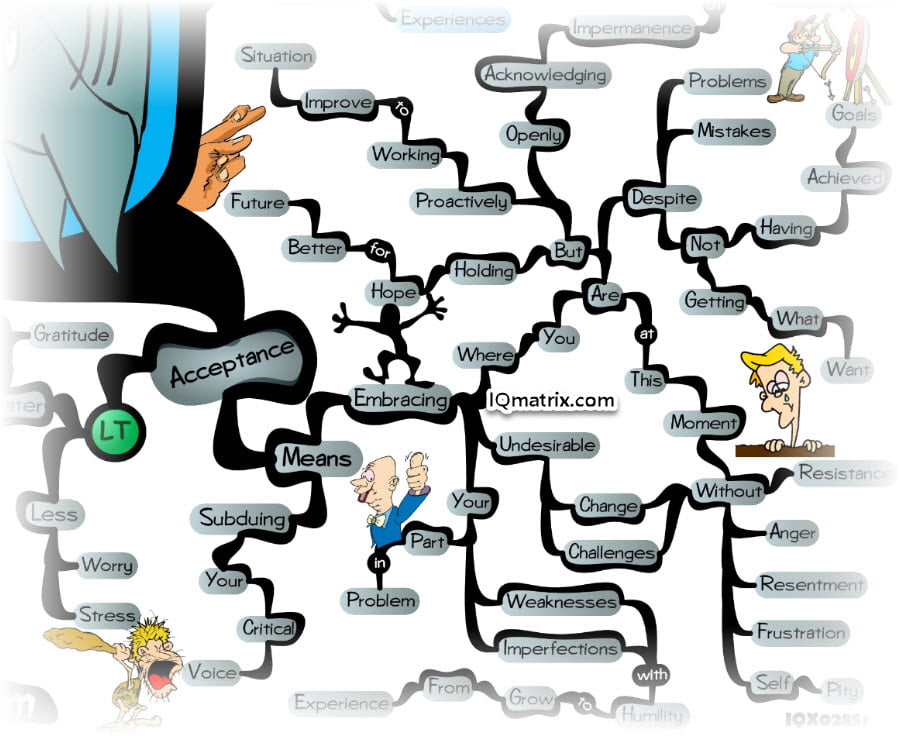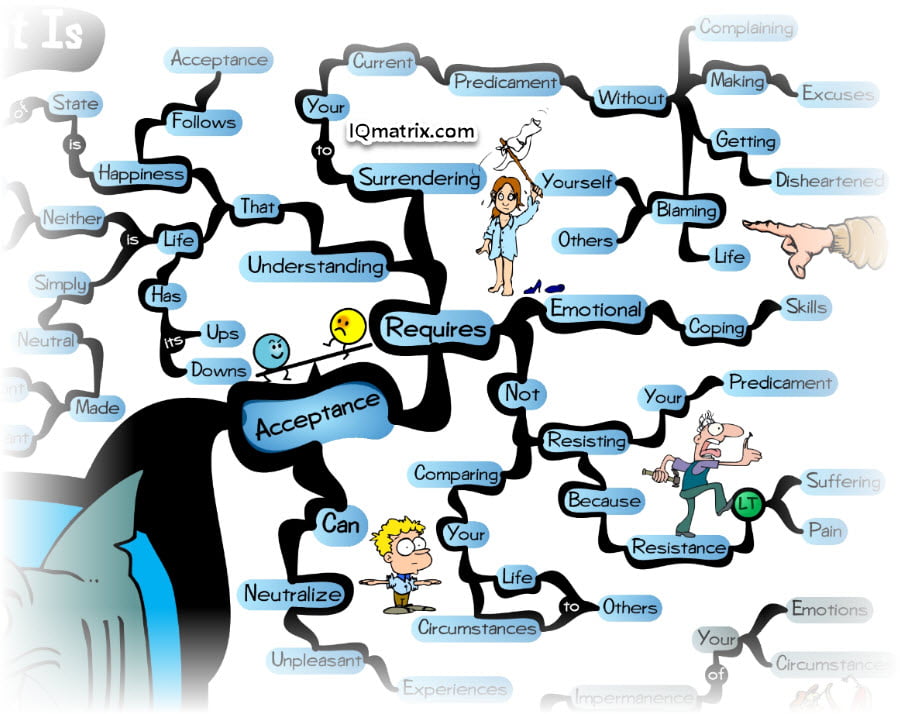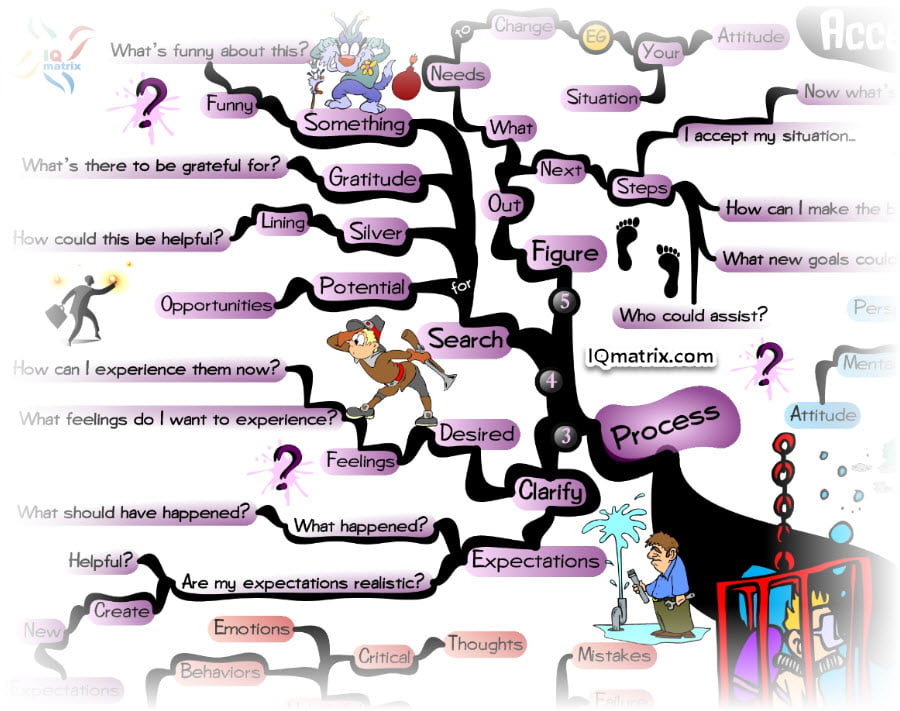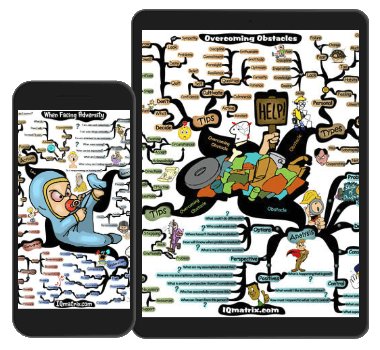Acceptance doesn’t mean resignation; it means understanding that something is what it is and that there’s got to be a way through it. – Michael J. Fox
Is it better to accept or to resist adversity?
Life is extremely tough. There are just too many problems to deal with, and too many variables out of our control. Things go wrong unexpectedly, and our emotions get taxed. People do what they like, and not what we expect, and all this uncertainty makes us feel kind of helpless, hopeless, and miserable.
In such instances, we, of course, have two choices. We can either accept what is without resistance, or we can fight against these oppressive forces that keep holding us back from living life on our terms.
When we choose to resist, we often do so with anger, frustration, resentment — with all this bottled up energy that can lead us astray. We become seduced by these difficult emotions and struggle to make optimal decisions that could help us move forward in a better way.
When we resist, we choose to fight against our circumstances. Things, of course, are the way they are. But we can’t accept that. We just can’t accept the fact that we are in a disadvantaged position. And so we choose to put on our boxing gloves and do everything within our power to resist this combatant. We effectively become our own worst enemy. In fact, the only combatant we face is our own shadow self. Or more specifically, our own fears, insecurities, and inadequacies.
When we resist, our critical voice takes control. We start to judge, criticize, make excuses, complain and lay blame on anything and anyone but ourselves. In other words, we take no responsibility for our predicament and do everything in our power to resist the reality we find ourselves in. This is a tough way to live life.
Yes, problems are challenging, and dealing with them doesn’t feel great. But does resistance actually make things any better? Typically, it makes things worse because you’re focused on playing the victim of circumstance. Ironically, as a victim, you are acknowledging that you have no control and that the world and other people are somehow conspiring against you.
As a second option, you could of course just accept how things are and choose to go with the flow of life. At least then you will feel a little better about yourself and avoid the drama of resistance.
Instead of resisting, you make peace with what has happened by taking responsibility for your predicament. In other words, you are choosing to live in the misery of your own problems while holding hope that things will turn around in the future. Yes, there is no resistance, but at the same time, there is also no real desire to change the predicament you find yourself in.
Given this, both resistance and acceptance do very little for you in the long-run. There must, therefore, be a third choice. A better option. And there is.
Acceptance with a Desire for Change
The third option is to accept our circumstances while focusing on the changes we would like to make, then taking massive action to make those changes a reality. In other words, it’s about accepting responsibility for our predicament, then adopting a solution-focused mindset to help us deal with our circumstances in an optimal way.
Therefore, when faced with an unexpected setback that derails your efforts, simply accept what has happened without resistance. What happened, happened. There’s nothing you can do about it. Accept what is, and now figure out how to use these circumstances to help you move forward in a better way. That is the idea behind acceptance within the context of this article.
This is, of course, all well and good. But what does it truly mean to live this way? And how can we make the most of the setbacks, problems, and adversity that life often throws our way? Let’s discuss that in the remainder of this article.
What it Means to Fully Embrace and Accept Our Circumstances
To accept means to embrace where you are at this very moment without resistance. It means fully acknowledging the impermanence of your emotions and circumstances while holding hope for a better future.
You may not have achieved your outcome or your desired goal, and that’s okay. You fully accept your failures, mistakes, and limitations and begin preparing yourself to proactively work on improving the situation.
To accept means embracing change and challenges without anger, resentment, frustration or self-pity. Moreover, it means wholeheartedly embracing your weaknesses and imperfections with humility and a desire to grow from your experience.
Often, when we choose the path of resistance, we subsequently fail to see that we are actually a part of the problem. And failure to see ourselves as an integral part of the problem denies us the opportunity to successfully work through the problem.
Many people, of course, struggle to accept how things are because their inner critic controls the direction of their thoughts. Their language patterns and unhelpful thinking styles prevent them from seeing things clearly.
Things are never how they are, but rather how we see how they are, and what we believe about them. In other words, how we interpret our reality or the circumstances of our reality is essentially what drives us forward or holds us back in life.
All this sounds wonderful on the surface, but it’s actually quite difficult to accept life when we’re buried under a rubble of our problems. When everything is suddenly going wrong, and we seem to have very little control over our life or circumstances, it’s hard to think rationally and objectively.
Given this, acceptance is something that we need to get into the habit of integrating into our lives. It’s a mindset that we must progressively learn to adopt to help us effectively manage life’s problems. But developing this mindset isn’t easy and can take time. In fact, it requires us to be a certain way.
The Requirements for Living a Life of Acceptance
Learning to accept how things are can instantly help us to neutralize unpleasant experiences that typically overwhelm most people. But, the question of course is, how do we do this?
To accept requires understanding that happiness always follows acceptance. Yes, it’s a state-of-mind, and nothing else. It’s not a technique, but rather a rational perspective you bring to every situation.
Life is neither positive nor negative. Yes, it appears to have its ups and downs, but an upward spike for one person translates to a downward spike for another person. Life and circumstances, in general, are therefore open to interpretation. What one person perceives as bad luck, another person thanks God for their good fortune. It’s just a matter of how we see things, or in other words, how we interpret things.
The stories you tell yourself about your predicament influence your perspective of the situation. Tell yourself wonderful stories filled with hope and opportunity, and you will instantly see things in a new way.
Life, therefore, is simply neutral. It’s made pleasant or unpleasant based on our thoughts, perspectives, and mental attitude.
To truly embrace acceptance, requires surrendering yourself to your current predicament without complaining, blaming, or making excuses. It requires a non-resistant approach.
Resistance, of course, typically leads to great suffering and pain. As we deny our reality, we are simultaneously giving up all hope of positive change. With no hope, there is only room for complaining and blaming. We don’t accept responsibility and therefore succumb to the victim mentality trap. This subsequently places circumstances out of our hands, and we continue to live with a great deal of uncertainty hanging over our heads.
All this leads to a great deal of emotional turmoil. And this is why a mindset of acceptance requires that we develop our emotional coping skills. It’s so that we don’t fall prey to habitual emotional patterns that prevent us from seeing our circumstances rationally and objectively.
When we choose to adopt a mindset of acceptance, this naturally leads to less worry and less stress about the uncertainties of life. It also promotes greater levels of happiness, contentment, and a deeper sense of gratitude. There is more appreciation for life and greater peace-of-mind.
A mindset of acceptance is a key requirement for change — for any change that is forced upon us. And all the problems and adversity you face mainly comes down to nothing more but change that is trying to nudge you in a new direction. Resisting that change could very well be counterproductive. But, on the other hand, embracing it might lead you down an incredible path of brand new opportunities and possibilities that you never previously imagined.
How to Develop the Mindset of Acceptance
Let’s now break down a five-step process that can help you develop a mindset of acceptance. Use these five steps whenever you face a difficult situation, where your first instinct is to resist the change that is suddenly brought upon you.
Working through each step of the process will help you stay calm and collected when adversity strikes. Furthermore, it will help you get very clear about what it is you can do to move through these circumstances in an optimal way.
Step 1: Find Your Peace
When something unexpected suddenly happens — sending your life into turmoil, — your first call to action is to make peace with these circumstances. To make peace with life.
Life is always utterly chaotic and unpredictable. It’s constantly changing, and we are, of course, part of that change. To begin cultivating a mindset of acceptance, you must make peace with the fact that at times life isn’t going to go your way. Things will happen that you wish didn’t, and you will have problems on your hands that you rather not deal with.
Next, you must make peace with Murphy’s Law. Murphy’s Law states that anything that can go wrong will go wrong, at the worst possible time all at once. The reality is that bad things happen to good people. And it’s difficult to prepare for such scenarios. This, however, doesn’t mean that life is out to get you. It’s simply a process of change that is trying to take place. Accepting that things can go wrong will help you make peace with circumstances when the world suddenly decides to fall apart under your feet.
What happens, happens. What’s done, is done and can’t be undone. Rarely if ever can we change such things. So, there’s really no point crying over spilled milk, right? Yes, you could’ve been more careful before spilling the milk, but things didn’t pan out that way. Instead of complaining about it, take proactive action to clean up the mess.
You, of course, don’t have to feel good about what has happened. This isn’t about positive thinking. It’s rather about non-resistance. The sooner you accept what is, the sooner you can move on to bigger and better things. Given this, it’s, therefore, imperative to also make peace with your feelings. Don’t let them get out of hand and spiral out of control. Subdue your feelings and see the situation rationally and objectively.
When circumstances don’t go your way, make peace with how things are by shifting how you think about these circumstances.
Things are the way they are…
I might not like them…
I might not understand them… but I do accept them.
Everything happens for a reason…
I am essentially where I need to be… I trust the process.
Success doesn’t follow a straight line…
Life will continuously test my resolve…
There is a lesson in this that I am determined to find.
It’s not what happens to us that matters, it’s rather how we perceive what happens. Seeing things a certain way will help you to make peace with what happened. You can then use that mindset to help you make the most of your circumstances moving forward. Acceptance though is the key.
Step 2: Consciously Let Go All Resistance
At this stage, you might still feel a lot of resistance. Something unexpected happened that is causing you massive problems. It’s easy at this point to think that life is unfair. Or worse, that life is purposefully conspiring against you. There is, of course, no truth to this.
Life is life. It is, how it is. It’s neither good nor bad, right nor wrong. It’s rather how we make it out to be. Or in other words, it’s how we perceive it to be. Unless we accept that life is simply life, we will struggle with resistance.
Yes, of course, you might have made a big blunder or failed miserably. But, that’s okay. Things are the way they are. Let go of past mistakes, failure, and regrets. These things aren’t relevant anymore. Let go of your critical thoughts, your limiting emotions and all those behaviors that are hindering you in this particular situation.
Choose instead to practice forgiveness, self-love, and self-compassion. You are human, and humans make mistakes. Seemingly horrible things happen to the best people, and there’s little we can do about it. What happened, has happened. Just be there within this moment with yourself.
See yourself as disconnected from the circumstances you face. See yourself as a witness who is removed from the situation. A witness who sees these circumstances rationally and objectively. That is the only way you will make the most of your predicament.
Step 3: Get Clear About Your Expectations
Now that you are feeling calm, collected and focused, it’s time to get clear about what exactly happened and the expectations you brought into this situation. Ask yourself:
What happened?
What do I feel should have happened?
Were my expectations realistic? Were they helpful?
Given what happened, what expectations would it be helpful to have at this very moment?
Why would these expectations be of value?
Our expectations dictate how we feel about our circumstances. For instance, someone who comes into a scenario with no expectations can’t really feel any disappointment. Or, let’s say that they come in with very negative expectations, but the circumstances turn out a little better than their worst fears. How would that make them feel? Probably somewhat relieved.
When you have an expectation of something, this is closely tied to certain feelings you expect to experience. However, the feelings we experience are essentially only based on our interpretations of our circumstances. Interpret things one way, and you will experience a positive feeling. Interpret things another way, and you will experience a negative feeling.
With this in mind, it can be helpful to clarify the desired feelings you want to experience in this particular situation. Ask yourself:
What feelings do I want to experience about these circumstances?
What would I need to think and believe about this situation to experience these feelings?
How can I potentially trick myself into experiencing these feelings right now?
Playing around with your feelings in this way helps you develop a more open and receptive state-of-mind that you can then use to make the most of your predicament.
Step 4: Search for the Silver Lining
Now, that you are in a more optimal and receptive state-of-mind, it’s time to search for the silver lining.
No matter how bad things get, there is almost always something you can do to move forward in a better way.
Often, things are probably not as bad as you make them out to be. In fact, the problem you face could very well turn into your greatest opportunity. However, unless you take the time to identify that opportunity, you will, unfortunately, fail to make the most of your circumstances. Ask yourself:
What’s the silver lining here?
How could this problem actually be helpful?
What’s there to be grateful for?
What’s funny about this that I hadn’t previously realized?
Gratitude and humor are the two key ingredients that can help you break down the walls between you and potential opportunities you could take advantage of.
I’m, of course, not saying that it’s easy to think about things this way when in the midst of your worst nightmare. But it’s a start. It’s a step that you need to be willing to take. Neglecting this step will only keep you stuck in a miserable and uncontrollable state-of-mind that will prevent you from moving forward.
Step 5: Figure Out Your Next Steps
The final step of the process is to figure out your next steps.
You have by this stage completed all the groundwork for building an optimal state-of-mind. It’s now time to figure out how you will proceed moving forward.
It’s important to mention that forward movement often requires some type of change or sacrifice. It requires you either change your approach or change the mindset you are bringing into the situation. It also requires potentially sacrificing something you value for the greater long-term good.
Yes, these decisions won’t be easy. You may very well need to experience bouts of short-term pain doing things you don’t want to do to successfully work through your predicament. Sacrifices are a part of life. They are a part of success and a necessary component of working through our life problems. Ask yourself:
How can I potentially make the best of this situation?
What new goals could I set?
What would these goals require of me?
What sacrifices might I need to make to achieve these goals?
What specifically is the next step I need to personally take?
How will I take that step? What is required?
Who could potentially help me work through this problem successfully?
In the end, you need to commit yourself to making consistent changes and taking massive action in the direction of your new objective. Only in this way will you find a means to work through your problem successfully.
Concluding Thoughts
Life is full of problems. It’s unpredictable, and circumstances can change very quickly. When we choose to resist the circumstances that are thrown our way, we deny ourselves the opportunity to move forward in a better way.
When something awful happens, we can choose to cry over spilled milk or decide to clean up the mess.
What happened, happened. We can’t change that. So there’s no point in making excuses or complaining about how things are. Instead, we can choose to do everything within our power to make things better. And acceptance is, of course, the very first step toward bringing about that change.
Time to Assimilate these Concepts
Did you gain value from this article? Is it important that you know and understand this topic? Would you like to optimize how you think about this topic? Would you like a method for applying these ideas to your life?
If you answered yes to any of these questions, then I’m confident you will gain tremendous value from using the accompanying IQ Matrix for coaching or self-coaching purposes. This mind map provides you with a quick visual overview of the article you just read. The branches, interlinking ideas, and images model how the brain thinks and processes information. It’s kind of like implanting a thought into your brain – an upgrade of sorts that optimizes how you think about these concepts and ideas. 🙂
Recommended IQ Matrix Bundles
If you’re intrigued by the idea of using mind maps for self-improvement then I would like to invite you to become an IQ Matrix Member.
If you’re new to mind mapping or just want to check things out, then register for the Free 12 Month Membership Program. There you will gain access to over 90 mind maps, visual tools, and resources valued at over $500.
If, on the other hand, you want access to an ever-growing library of 100s of visual tools and resources, then check out our Premium Membership Packages. These packages provide you with the ultimate visual reference library for all your personal development needs.
Gain More Knowledge…
Here are some additional links and resources that will help you learn more about this topic:
- 3 Touching True Stories that Illustrate the Power of Acceptance @ Reader’s Digest
- Accept Your Pain; It Will Hurt Less @ Psychology Today
- Leave it, Change it, Accept it @ Mind Body Green
- Stop Resisting and Learn to Accept @ Elite Daily
- The Power of Acceptance: Stop Resisting and Find the Lesson @ Tiny Buddha
- There’s No Such Thing as Letting Go, There’s Just Accepting What’s Already Gone @ Thought Catalog
- What it Means to Practice Radical Acceptance @ Psych Central









